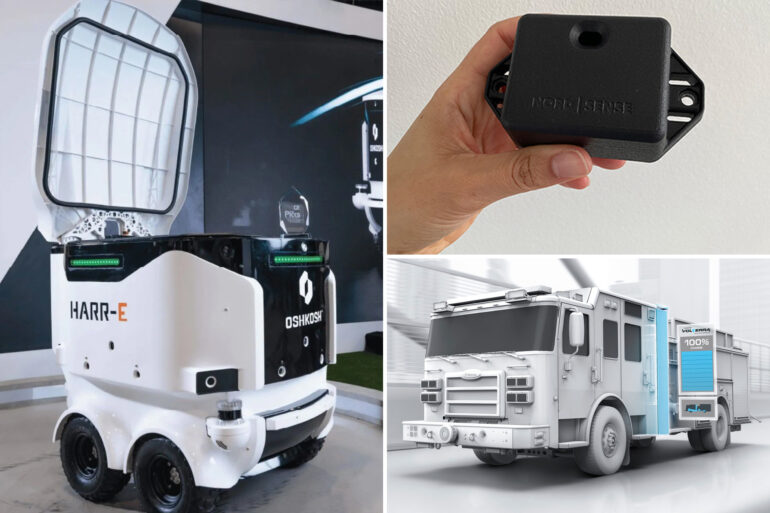🔴 Website 👉 https://u-s-news.com/
Telegram 👉 https://t.me/usnewscom_channel
The humble garbage run is getting a high-tech overhaul.
From robot trash haulers that arrive on demand to electric trucks designed to silence the morning clatter of diesel engines, waste collection is becoming one of the next frontiers in automation and clean transportation.
Oshkosh Corporation, the Wisconsin-based manufacturer best known for military and heavy-duty trucks, recently unveiled HARR-E, a self-driving trash robot that promises to make garbage pickup as easy as hailing a ride.
Shown off earlier this year at the Consumer Electronics Show, the battery-powered unit uses advanced sensors to navigate neighborhoods and business parks.
“When your bin gets full, you request a pickup through an app, and the robot travels to your home on its own,” Jennifer Stiansen, Oshkosh’s vice president of global branding and communications, told The Cool Down earlier this year.
“With HARR-E, you could have on-demand trash service.”
The robot, about the size of a small cart, ferries waste to a central collection point where larger trucks take over.
It is designed for planned communities and campuses where centralized trash facilities are already in place.
Advocates say the system could mean fewer missed pickups, less neighborhood noise and a cut in emissions from heavy trucks rumbling down residential streets each week.
At the same time, Nordsense, a Danish-American company with offices in Copenhagen and Sunnyvale, California, is trying to make the bins themselves more intelligent.
Its smart sensors measure fill levels, orientation and even temperature every 15 minutes, transmitting data to the cloud.
That information helps municipalities send trucks only where needed, rather than following fixed routes.
“The sensors provide high-accuracy depth maps of bin contents, cutting down on unnecessary collections and overflow,” the company says.
Early adopters such as Goodwill Industries of Kanawha Valley in West Virginia say the data has helped them increase efficiency and keep bins from overflowing.
Other case studies show reductions of up to 30% in CO₂ emissions from optimized collection routes.
The last piece of the puzzle is the garbage truck itself.
Oshkosh subsidiary McNeilus has developed the Volterra ZSL electric refuse vehicle, billed as the first fully integrated electric garbage truck in North America.
Powered by lithium-ion batteries and a proprietary electric axle, the truck is designed to complete a full day’s route on a single charge.
Unlike diesel trucks, it operates almost silently and produces no tailpipe emissions.
Waste management operators have long complained about the high cost of fuel and maintenance for traditional refuse trucks.
Electric versions promise not only cleaner air but also lower lifetime operating costs, though they require significant upfront investment in charging infrastructure.
The trash innovations are part of Oshkosh’s broader push into electrification.
The company has already supplied the first electric fire truck in North America, delivered to Madison, Wis., as well as electric airport rescue vehicles and a new electric concrete placement truck.
It is also the manufacturer behind the US Postal Service’s Next Generation Delivery Vehicle, which is being produced in both battery-electric and low-emission combustion versions.
Industry experts caution that widespread adoption will take time. Smart bins and sensors need upfront investment, and electric refuse trucks can cost up to twice as much as diesel counterparts.
On-demand trash robots like HARR-E may initially be limited to master-planned communities, rather than citywide deployments.
Still, momentum is building. Cities including Los Angeles, New York and Toronto have set targets to electrify portions of their waste fleets within the next decade.
And with labor shortages in sanitation departments, automation could help stretch limited manpower further.
For residents, the most noticeable change may be what they no longer hear: the clanging and roaring of diesel trucks at dawn. Instead, quieter electric haulers — or small self-driving carts — could roll by with minimal disruption.
“Trash collection has looked the same for decades,” said Stiansen of Oshkosh.
“We’re at the beginning of a transformation that will make it cleaner, quieter, and more efficient.”
There is no set timeline for when systems like HARR-E will be widely deployed.
Oshkosh has not announced pricing or launch dates, and Nordsense is still expanding its sensor rollout city by city.
But the technologies are no longer prototypes — they are being tested in the field now.

